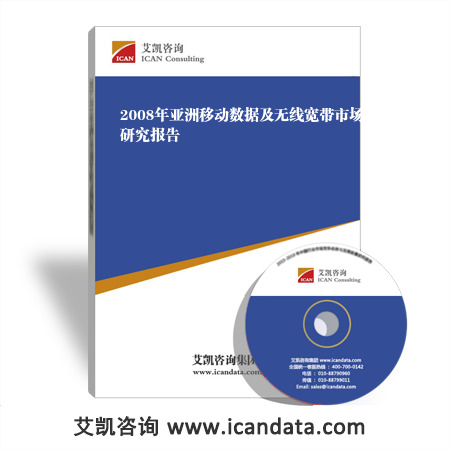数据来源与研究方法:
- 对行业内相关的专家、厂商、渠道商、业务(销售)人员及客户进行访谈,获取最新的一手市场资料;
- 艾凯咨询集团对长期监测采集的数据资料;
- 行业协会、国家统计局、海关总署、国家发改委、工商总局等政府部门和官方机构的数据与资料;
- 行业公开信息;
- 行业企业及上、下游企业的季报、年报和其它公开信息;
- 各类中英文期刊数据库、图书馆、科研院所、高等院校的文献资料;
- 行业资深专家公开发表的观点;
- 对行业的重要数据指标进行连续性对比,反映行业发展趋势;
- 通过专家咨询、小组讨论、桌面研究等方法对核心数据和观点进行反复论证。
报告简介:

摘要
This market report provides an overview of the Mobile Data and Wireless Broadband Market segment across the various markets of Asia. Some 27 Asian countries are covered in the report. It is noted that the amount of information offered is obviously dependent on the relative size of the market in each of the respective countries. The coverage in the report also results in some segment overlap as we see increased convergence in the mobile data and wireless broadband markets.
Mobile data services in Asia
With some 1.4 billion Asians using mobile phones by March 2008, the region’s mobile markets offer huge potential for mobile data services.
The growth of wireless Internet in Asia is being driven by competition in the market place and by the advent of 3G and 3.5G services. Market competition has been driving handset prices and airtime tariffs downward, thus opening up mobile services to wider adoption. Adoption of wireless Internet has started to rise with the overall increase in mobile penetration and as networks are progressively upgraded to next generation platforms.
While 3G licensing and the ongoing launch of 3G services in Asia has certainly been promoting growth of wireless data services, 3G has also been providing opportunities for both wireless access and content providers in domestic markets. In South Asia, in particular, more people own a mobile phone than a PC, giving the delivery of mobile data services huge potential there.
Mobile data is not a new phenomenon in Asia. Regional public networks based on Mobitex technology were established in Singapore, Indonesia and South Korea. Another form of mobile data, the DataTAC network, was made available in Hong Kong, Malaysia, Singapore and Thailand, with network trials in South Korea, Japan and China. The DataTAC networks established in Asia were more extensive than the corresponding networks in either Europe or the US.
An example of widespread adoption of a particular mobile data service has been the SMS capability of GSM and other digital cellular technologies. SMS, which allows the sending and receiving of basic text messages, became very popular throughout Asia, with remarkable growth being experienced in the Philippines and Malaysia, as well as in China.
The business plans of the majority of mobile operators have been built on the assumption that the key to further revenue growth lies in the ability to offer more value-added services and, in particular, access to the Internet. A number of technologies are competing for the region’s mobile Internet market. In Singapore, Hong Kong, South Korea, and a number of other countries, in an effort to chase this market, offerings based on the WAP standard were tried. Apart from South Korea, however, WAP failed to claim any significant share of the market. In Japan, by contrast, NTT DoCoMo launched its i-Mode service and its two rivals –SoftBank and KDDI – launched their own versions of i-Mode with dramatic success, with almost 50% of Internet users in Japan logging on from a mobile using one of these platforms. Another system that has supported mobile data, the GPRS, grew out of GSM. Labelled as a 2.5G technology, it has been adopted in a significant number of Asian markets.
The widespread adoption of HSDPA, a new generation (3.5G) mobile telephone protocol, is also noted throughout Asia. It is an evolution of the WCDMA 3G standard, designed to increase the available data rate by a factor of 5 or more. In effect, it extends the capabilities of WCDMA in the same way that EV-DO extended CDMA2000, allowing higher data capacity (up to 14.4Mb/s). SK Telecom launched a commercial HSDPA network in 25 major cities in South Korea in May 2006, offering customers what it claimed was the world’s first commercial HSDPA-enabled mobile handset, the Samsung SCH-W200. This was followed SmarTone-Vodafone launching a system in Hong Kong in June 2006, providing a data speed of 1.8Mb/s. Others have quickly followed.
Wireless broadband in Asia
After a somewhat tentative start, wireless broadband access in its various forms is starting to take hold in Asia. This has seen a flurry of activity as operators rush to acquire the necessary frequency licences. The sector had experienced problems earlier on involving unreliable equipment and network design faults. These have become things of the past. The challenge still facing the industry, however, is to establish viable business models that allow wireless to compete with the more established service offerings – DSL and cable modem platforms in the case of fixed wireless broadband and next generation mobile telephony platforms in the case of mobile wireless broadband. Wireless broadband systems are expected to eventually become a key feature of the broadband access landscape across Asia. Apart from WiFi and WiMAX platforms, wireless technologies include LMDS and MMDS.
For some years now, despite high equipment prices and security issues inhibiting adoption, wireless broadband services have been appearing in a piecemeal fashion across the region, notably in airport lounges, transport hubs and hotels, particularly offering mobile travellers immediate broadband connectivity.
As with other high technology services, it is the developed economies that have been leading the way in this segment of the telecom market in Asia. At the same time, however, wireless broadband technologies are certain to prove increasingly popular in the developing markets as they offer a powerful means of by-passing the incumbent’s infrastructure, especially the ‘last mile’ and also accessing customers where the incumbent’s infrastructure finds it difficult. These possibilities will become even more attractive as the cost of equipment falls with more roll-outs occurring and the market demand volume rising. This pattern has already started to emerge.
While there has been some activity in the providing of WiMAX networks, the real test will be the advent of mobile WiMAX. The initial roll-out of mobile WiMAX in Asia has begun but it has been a cautious start. The technology continues to be strongly supported at this stage of its development. The big question is whether it will become a mass market platform or simply satisfy a niche market need.
It should be noted that gathering statistics for broadband subscribers in Asia has become difficult with the advent of wireless services and hotspots. One phenomenon that makes it difficult is the practice of service ‘bundling’ by operators. Korea Telecom, for example, had a large number of WiFi subscribers, approximately two-thirds of which were ‘bundled’ as subscribers on the operator’s DSL service.
目录及图表
1. Afghanistan
1.1 Mobile data
1.2 Wireless broadband
1.2.1 Internet cafes
2. Armenia
2.1 Mobile data
2.2 Wireless broadband
2.2.1 Wireless Internet
2.2.2 Arminco Global Telecommunications
3. Bangladesh
3.1 Mobile data
3.1.1 Overview
3.1.2 Short Message Service (SMS)
3.1.3 Mobile portal service
3.1.4 Wireless Internet
3.2 Wireless broadband
3.2.1 AlwaysOn
3.2.2 WiMAX
4. Bhutan
4.1 Mobile data
4.2 Wireless broadband
4.2.1 Samden Tech
5. Cambodia
5.1 Mobile data
5.1.1 Cambodia GSM (MobiTel)
5.2 Wireless broadband
5.2.1 MediaRing’s acquisition of AngkorNet
5.2.2 WiMAX
6. China
6.1 Mobile data
6.1.1 Market overview
6.1.2 Mobile data statistics
6.1.3 Regulatory issues
6.1.4 Satellite Terrestrial Interactive Multi-service Infrastructure (STiMi) platform
6.1.5 Short Message Service (SMS)
6.1.6 Multimedia Messaging Service (MMS)
6.1.7 Wireless Application Protocol (WAP)
6.1.8 General Packet Radio Service (GPRS)
6.1.9 Push-to-talk (PTT)
6.1.10 Enhanced Data for GSM Evolution (EDGE)
6.1.11 Broadband wireless data services
6.1.12 BlackBerry
6.1.13 Mobile TV
6.2 Mobile content and applications
6.2.1 Market overview
6.2.2 A surge in new applications development
6.2.3 Global positioning systems (GPS)
6.2.4 M-commerce
6.2.5 Mobile Video-on-Demand (VoD)
6.2.6 Mobile gaming
6.2.7 Instant Message (IM) search services
6.2.8 Ringtones
6.2.9 Mobile music
6.2.10 Push email
6.3 Wireless broadband
6.3.1 Wireless Local Area Networks (WLANs)
6.3.2 WiFi
6.3.3 World Interoperability for Microwave Access (WiMAX)
6.3.4 Analysis – WiMAX still not high on the agenda in China – April 2007
6.3.5 Analysis – WiMAX – September 2007
6.3.6 WLAN Authentication and Privacy Infrastructure (WAPI)
6.3.7 Wireless Local Loop (WLL)
6.3.8 Broadband Fixed Wireless Access (BFWA)/Local Multipoint Distribution System (LMDS)
6.3.9 Broadband via satellite
7. Georgia
7.1 Wireless broadband
7.1.1 WiMAX
8. Hong Kong
8.1 Mobile data
8.1.1 Short Message Service (SMS)
8.1.2 Multimedia Message Service (MMS)
8.1.3 Wireless Application Protocol (WAP)
8.1.4 General Packet Radio Service (GPRS)
8.1.5 Push-to-talk over Cellular (PoC)
8.1.6 High-Speed Circuit-Switched Data (HSCSD)
8.1.7 Enhanced Data for GSM Evolution (EDGE)
8.1.8 High-Speed Downlink Packet Access (HSDPA)
8.1.9 Mobile TV
8.1.10 Wireless data
8.2 Mobile content and applications
8.3 Wireless broadband
8.3.1 Wireless Internet
8.3.2 SmarTone Broadband Services
9. India
9.1 Mobile data
9.1.1 Market overview
9.1.2 Short Message Service (SMS)
9.1.3 Multimedia Messaging Service (MMS)
9.1.4 General Packet Radio Service (GPRS)
9.1.5 Push-to-talk over Cellular (PoC)
9.1.6 Binary Runtime Environment for Wireless (BREW)
9.1.7 Enhanced Data for GSM Evolution (EDGE)
9.1.8 Mobile entertainment
9.1.9 i-mode
9.1.10 BlackBerry
9.1.11 Mobile TV
9.2 Mobile content and applications
9.2.1 Gaming
9.3 Wireless broadband
9.3.1 WiMAX
9.3.2 Satellite
10. Indonesia
10.1 Mobile data
10.1.1 Short Message Service (SMS)
10.1.2 Multimedia Messaging Service (MMS)
10.1.3 Mobile TV
10.1.4 Other services
10.2 Wireless broadband
10.2.1 World Interoperability for Microwave Access (WiMAX)
10.2.2 Wireless LANs (WLAN)
10.2.3 Internet via satellite
11. Japan
11.1 Mobile data
11.1.1 Analysis – mobile data market
11.1.2 Mobile Internet
11.1.3 Short Message Service (SMS)
11.1.4 Multimedia Messaging Service (MMS)
11.1.5 General Packet Radio Service (GPRS)
11.1.6 Push-to-talk (PTT)
11.1.7 BlackBerry
11.2 Mobile content and applications
11.2.1 Content for mobile market
11.2.2 Global Positioning System (GPS)
11.2.3 M-commerce/m-cash
11.2.4 Mobile gaming
11.2.5 Mobile conferencing
11.2.6 Mobile videoconferencing / mobile video
11.2.7 Mobile TV and radio
11.2.8 Mobile ringtone and music downloads
11.2.9 QR code readers
11.2.10 Mobile books
11.2.11 Mobile Applications
11.3 Wireless broadband
11.3.1 Wireless LAN (WLAN)
11.3.2 Major WLAN providers
11.3.3 WiMAX
11.3.4 Voice over WLAN (VoWLAN)
11.3.5 Ultra Wideband (UWB)
11.3.6 Local Multipoint Distribution System (LMDS)
11.3.7 Broadband Internet via satellite
12. Kazakhstan
12.1 Mobile data
12.1.1 GSM-Kazakhstan (K’Cell)
12.1.2 Kar-Tel (K-Mobile)
13. Laos
13.1 Wireless broadband
13.1.1 Wireless broadband statistics
14. Malaysia
14.1 Mobile data
14.1.1 Short Message Services (SMS)
14.1.2 Multimedia Messaging Service (MMS)
14.1.3 Wireless Application Protocol (WAP)
14.1.4 General Packet Radio Service (GPRS)
14.1.5 InterReach Unison
14.1.6 Mobile TV/Video on Demand (VoD)
14.2 Mobile content and applications
14.2.1 Gaming
14.2.2 M-commerce (micropayments)
14.2.3 Blogging
14.3 Wireless broadband
14.3.1 Overview
14.3.2 WiMAX
14.3.3 Time dotCom
14.3.4 NasionCom
14.3.5 Maxis Net
14.3.6 iZZinet
14.3.7 Internet via satellite
15. Mongolia
15.1 Wireless broadband
16. Myanmar
16.1 Mobile data
16.1.1 Mobile broadcasting
16.2 Wireless broadband
16.2.1 WiMAX
17. Nepal
17.1 Mobile data
17.1.1 Nepal Telecom
17.2 Wireless broadband
17.2.1 WiFi network for remote villages
18. Pakistan
18.1 Mobile data
18.1.1 SMS
18.1.2 MMS
18.1.3 Mobile TV
18.2 Wireless broadband
18.2.1 WiMAX
18.2.2 Internet via satellite
19. Philippines
19.1 Mobile data
19.1.1 Short Message Service (SMS)
19.1.2 Multimedia Message Service (MMS)
19.1.3 Wireless Application Protocol (WAP)
19.1.4 General Packet Radio Service (GPRS)
19.1.5 Enhanced Data Rates for GSM Evolution (EDGE)
19.1.6 Mobile TV
19.2 Mobile content and applications
19.2.1 Mobile tracking
19.2.2 M-commerce
19.3 Wireless broadband
19.3.1 Market overview
19.3.2 Broadband Philippines
19.3.3 Next Mobile
19.3.4 Meridian
19.3.5 Pacific Internet (PacNet)
19.3.6 BellTel
19.3.7 Globe Telecom
19.3.8 WiFi
19.3.9 WiMAX
19.3.10 BlackBerry
19.3.11 Internet via satellite
20. Singapore
20.1 Mobile data
20.1.1 Short Messaging Service (SMS)
20.1.2 Multimedia Messaging Service (MMS)
20.1.3 Wireless Application Protocol (WAP)
20.1.4 General Packet Radio Service (GPRS)
20.1.5 i-mode
20.1.6 Other developments
20.1.7 M1
20.1.8 StarHub
20.1.9 Mobile TV
20.2 Mobile content and applications
20.2.1 Location-based services
20.3 Wireless broadband
20.3.1 Overview
20.3.2 Allocation of wireless broadband spectrum
20.3.3 Local Multipoint Distribution System (LMDS)
20.3.4 WiFi
20.3.5 The Wireless@SG initiative
20.3.6 Ultra-Wideband (UWB)
20.3.7 Internet via satellite
21. South Korea
21.1 Mobile data
21.1.1 Market overview
21.1.2 Mobile Internet
21.1.3 Short Message Service (SMS)
21.1.4 Multimedia Messaging Service (MMS)
21.1.5 Wireless Application Protocol (WAP)
21.1.6 Push-to-talk (PTT)
21.1.7 Mobile TV broadcasting/Digital Multimedia Broadcasting (DMB)
21.1.8 Mobile Video-on-Demand (mobile VoD)
21.2 Mobile content and applications
21.2.1 Overview
21.2.2 Video calls
21.2.3 Position location system/Global Positioning Systems (GPS)
21.2.4 Automobile telematics
21.2.5 M-commerce/m-payment
21.2.6 Mobile banking (m-banking)
21.2.7 M-government
21.2.8 M-magazines
21.2.9 M-Big Macs
21.2.10 M-movies
21.2.11 Remote home monitoring
21.2.12 Multi-lingual service
21.3 Wireless broadband
21.3.1 Overview
21.3.2 Wireless Local Area Network (WLAN)/Wireless Fidelity (WiFi)
21.3.3 Wireless Internet Platform for Interoperability (WIPI)
21.3.4 Broadband Wireless Local Loop (B-WLL)
21.3.5 Wireless Broadband (WiBro)
21.3.6 WiMAX
21.3.7 Broadband via satellite
21.3.8 Ultra Wideband (UWB) Wireless Personal Area Network (WPAN)
21.3.9 Hanaro Telecom/HanaNet
22. Sri Lanka
22.1 Mobile data
22.1.1 Dialog Telekom (MTN)
22.2 Wireless broadband
22.2.1 WiMAX
23. Taiwan
23.1 Mobile data
23.1.1 Short Message Service (SMS)
23.1.2 Multimedia Messaging Service (MMS)
23.1.3 Wireless Application Protocol (WAP)
23.1.4 General Packet Radio Service (GPRS)
23.1.5 Mobile Internet
23.1.6 Video calls
23.1.7 Push-to-talk (PTT)
23.1.8 WiMAX
23.2 Wireless broadband
23.2.1 WiMAX
23.2.2 M-Taiwan project
24. Tajikistan
24.1 Wireless broadband
24.1.1 WiMAX
25. Thailand
25.1 Mobile data
25.1.1 Short Message Service (SMS)
25.1.2 Multimedia Message Service (MMS)
25.1.3 Smart phones
25.1.4 Push-to-talk over Cellular (PoC)
25.1.5 Global Positioning System (GPS) service
25.2 Mobile content and applications
25.3 Wireless broadband
25.3.1 Overview
25.3.2 WiMAX
25.3.3 Internet via satellite
26. Uzbekistan
26.1 Wireless broadband
26.1.1 WiMAX
27. Vietnam
27.1 Mobile data
27.1.1 Short Message Service (SMS)
27.1.2 Multimedia Message Service (MMS)
27.1.3 Instant Messaging (IM)
27.1.4 Wireless Application Protocol (WAP)
27.1.5 General Packet Radio Service (GPRS)
27.1.6 Enhanced Data for GSM Evolution (EDGE)
27.2 Mobile content and applications
27.3 Wireless broadband
27.3.1 Satellite Internet
28. Glossary of Abbreviations
亚洲移动数据无线宽带
















